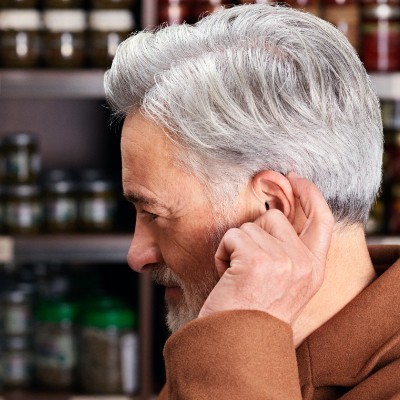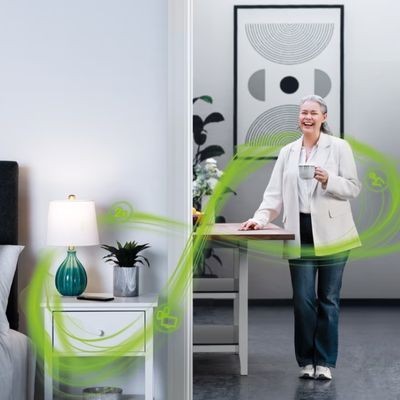
Head of Online Medical Content

Audiology Expert at Hearing Aid UK

What is Auracast and LE Audio?
A brief summary
Introduction | Why is Auracast better than classic Bluetooth? | Streaming with Auracast | Auracast and hearing aids | Disadvantages of Auracast | Conclusion
LE Audio and Auracast explained
LE Audio, part of the new Bluetooth 5.2 and 5.3 standards, is a low-power version of Bluetooth specifically designed for streaming audio.
This technology is particularly relevant in the UK, where the Equality Act 2010 requires public venues to make reasonable adjustments for people with disabilities. Auracast provides venues with a straightforward way to improve accessibility without requiring expensive infrastructure changes.
With it comes Auracast, a feature that allows an audio source to broadcast one or multiple audio streams to an unlimited number of receivers, like Bluetooth earbuds or hearing aids.
Auracast's low-energy consumption also helps to prolong battery life, ensuring extended usage without interruption. Its user-friendly interface simplifies device pairing and customisation, supporting hearing personalisation.
Why is it better than classic Bluetooth?
Bluetooth, introduced in 1999, was created for high-bandwidth wireless data transfer, including audio streaming, though that wasn’t its main purpose.
In contrast, when looking deeper into the technology, LE Audio uses the LC3 (Low Complexity Communication Codec). This means there's a wider range of bit rates and unlimited channels.
When looking at it from a hearing healthcare point of view, these advancements enhance accessibility, providing features like hearing aid support and making the overall Bluetooth experience more versatile and user-friendly compared to classic Bluetooth technology.
What is bit rate, and why is it important?
Bit rate is important because it determines how much information your audio transmits per second. To simplify, if the bit rate is higher, the audio quality will be higher too. Auracast and LE Audio significantly improve over classic Bluetooth by simply offering better sound quality, lower latency, and enhanced power efficiency.
Whilst classic still Bluetooth delivers good sound quality, switching to LE Audio brings a noticeable difference, thanks to the advanced LC3 codec we mentioned earlier.
Streaming audio with Auracast
With Auracast, you can connect to the TV's audio and stream it directly to your headphones or hearing aids, so there's no struggling to hear over the background noise. LE Audio allows hearing aid wearers, within range of a compatible transmitter, to connect to Auracast broadcasts with the press of a button or via an app.
This technology not only improves audio quality but also reduces power consumption, enabling developers to add more features without affecting battery life.
Big hearing aid brands like Signia and Oticon are already incorporating LE Audio into their hearing solutions, starting the global rollout of Auracast. This innovation looks promising and is set to revolutionise the next generation of hearing aids.
In the UK market, Auracast-enabled hearing aids are now available from most major manufacturers. Resound was among the first to launch Auracast-compatible devices in the UK with their Nexia range in late 2023, followed by Oticon's Intent range and Signia's IX platform.
Hearing aid users can expect many new premium and mid-range hearing aids to be released from 2024 onwards to include Auracast compatibility.
UK audiologists are beginning to recommend Auracast-enabled devices for patients who regularly attend theatres, concerts, or places of worship, as early adopter venues start to install this technology.
Auracast and hearing aids
To clarify, Auracast Bluetooth technology is already available in the latest hearing aids and is expected to become standard across most hearing aid models within the next few years.
It will also provide crystal-clear sound quality and eliminate background noise. This technological shift will improve the quality of life for those with hearing loss.
Any downsides to Auracast?
Like with all technology, Auracast has a few potential downsides. Compatibility is a concern, as older devices may not support Auracast, requiring users to upgrade to newer hardware.
For UK users on NHS hearing aids, adoption of Auracast will likely be slower, as NHS services typically use devices that are one or two generations behind the latest commercial models. Private hearing aid users have earlier access to Auracast-enabled devices.
UK accessibility charities, including the Royal National Institute for Deaf People (RNID), have welcomed Auracast technology and published reports exploring opportunities and challenges for UK rollout.
However, they've emphasised the importance of maintaining traditional induction loop systems alongside Auracast during the transition period, as many UK hearing aid users rely on telecoil technology.
According to RNID's 2024 figures, approximately 18 million people in the UK live with hearing loss, but it will take years before all have access to Auracast-compatible devices.
Private hearing aid users will have earlier access to Auracast-enabled devices, though many UK private providers offer flexible upgrade programmes and trial periods to help patients access the latest technology.
While Auracast is designed for low power consumption, some devices might still experience higher battery drain during extensive use.
Security could also be a problem, as the ability to broadcast to multiple devices might raise privacy issues if not properly managed. For more detailed information on Auracast, watch the video below or visit https://www.bluetooth.com/auracast/
UK rollout and future prospects: Where are we now?
The UK theatre sector appears to be leading Auracast adoption, with multiple London venues actively trialling or investigating the technology. However, widespread implementation across UK public spaces remains several years away. Industry forecasts suggest 1.5 million public venues globally will offer Auracast by 2029, though specific UK targets haven't been published.
For UK hearing aid users considering an upgrade, Auracast compatibility is worth including in your requirements if you regularly attend theatres, concerts, or places of worship. Whilst the infrastructure is still developing, venues are beginning to install transmitters, and early adopters will benefit as more locations come online.
Why Choose Us?
- FREE Hearing Tests
- Best Hearing Aids and Prices
- FREE Aftercare for Life
- FREE Home Visits
- 200+ Local Audiologists
- 60 Day Money Back Guarantee
What is Auracast and Le Audio?
Conclusion
Unlike traditional Bluetooth, which typically connects one device to another, Auracast enables sharing audio with a large audience, such as in public places, schools, or events.
This technology can be used for personal listening, like sharing music with friends, or for broader applications like transmitting announcements in airports.
Auracast enhances accessibility by supporting hearing aids and improving experiences in public venues, making wireless audio sharing more versatile and inclusive.
Other articles on hearing aid technology you might like...
 Deep Neural Networks in Hearing Aids
Deep Neural Networks in Hearing Aids  Resound Vivia AI vs Nexia
Resound Vivia AI vs Nexia  Phonak Infinio Ultra vs Phonak Infinio
Phonak Infinio Ultra vs Phonak Infinio Our specialist service includes:
Do not spend hundreds of pounds without getting a second opinion from us.
Please call us on 0800 567 7621
 Not only are the prices great, but the service is fantastic! Many thanks to your team.
Not only are the prices great, but the service is fantastic! Many thanks to your team.What's included in our hearing aid prices?
Common FAQs about hearing aids and hearing loss
In general, any audiologist will always recommend to you the hearing aid model that best suits your needs. Here is a useful checklist to make sure that is the case.
- Audiologist's level of knowledge: The audiologist you have seen will hopefully have a wide knowledge of all available hearing aids; however, some will only be familiar with a small number of brands and, therefore, may not really be in a position to know which model is the best for you. It is OK to challenge their recommendation and ask them to justify why this particular brand is the one for you.
- Do research: Read about the hearing aid that was recommended. Does it seem like it will suit your lifestyle? Does it have more or fewer features than you need?
- Be aware of sales targets: Many high street retailers have specific tie-ins to a particular manufacturer/brand. The hearing aid they have suggested may still be the correct one for you, but do your research so that you know why they might have recommended it.
If you have significant hearing loss in both ears, you should be wearing two hearing aids. Here are the audiological reasons why:
Localisation: The brain decodes information from both ears and compares and contrasts them. By analysing the minuscule time delays as well as the difference in the loudness of each sound reaching the ears, the person is able to accurately locate a sound source.
Simply put, if you have better hearing on one side than the other, you can't accurately tell what direction sounds are coming from.
Less amplification is required: A phenomenon known as “binaural summation” means that the hearing aids can be set at a lower and more natural volume setting than if you wore only one hearing aid.
Head shadow effect: High frequencies, the part of your hearing that gives clarity and meaning to speech sounds, cannot bend around your head. Only low frequencies can. Therefore, if someone is talking on your unaided side, you are likely to hear that they are speaking, but be unable to tell what they have said.
Noise reduction: The brain has its own built-in noise reduction, which is only really effective when it is receiving information from both ears. If only one ear is aided, even with the best hearing aid in the world, it will be difficult for you to hear in background noise as your brain is trying to retain all of the sounds (including background noise) rather than filtering them out.
Sound quality: We are designed to hear in stereo. Only hearing from one side sounds a lot less natural to us.
Fancy some further reading on this topic? You can read about why two hearing aids are better than one in our article, hearing aids for Both Ears, here
For most people, the main benefit of a rechargeable hearing aid is simple convenience. We are used to plugging in our phones and other devices overnight for them to charge up. Here are some other pros and cons:
For anybody with poor dexterity or issues with their fingers, having a rechargeable aid makes a huge difference, as normal hearing aid batteries are quite small and some people find them fiddly to change.
One downside is that if you forget to charge your hearing aid, then it is a problem that can't be instantly fixed. For most, a 30-minute charge will get you at least two or three hours of hearing, but if you are the type of person who is likely to forget to plug them in regularly, then you're probably better off with standard batteries.
Rechargeable aids are also a little bit bigger and are only available in Behind-the-Ear models.
Finally, just like with a mobile phone, the amount of charge you get on day one is not going to be the same as you get a few years down the line. Be sure to ask what the policy is with the manufacturer's warranty when it comes to replacing the battery.
For most people, the answer is yes. But it's never that simple.
The majority of hearing problems affect the high frequencies a lot more than the low ones. Therefore, open fitting hearing aids sound a lot more natural and ones that block your ears up can make your own voice sound like you are talking with your head in a bucket. Therefore, in-ear aids tend to be less natural.
However, the true answer is we can't tell until we have had a look in your ears to assess the size of your ear canal, and until we have tested your hearing to see which frequencies are being affected.
People with wider ear canals tend to have more flexibility, also there are open fitting modular CIC hearing aids now that do not block your ears.
There is also the age-old rule to consider, that a hearing aid will not help you if it's sat in the drawer gathering dust. If the only hearing aid you would be happy wearing is one that people can't see, then that's what you should get.
Most people can adapt to any type of hearing aid, as long as they know what to expect. Have an honest conversation with your audiologist as to what your needs are.
Generally speaking, six or more. Unless it's none at all. The number of channels a hearing aid has is often a simplistic way an audiologist will use to explain why one hearing aid is better than another, but channels are complex, and it is really not that straightforward. Here are some reasons why:
Hearing aids amplify sounds of different frequencies by different amounts. Most people have lost more high frequencies than low, and therefore need more amplification in the high frequencies. The range of sounds you hear is split into frequency bands or channels, and the hearing aids are set to provide the right amount of hearing at each frequency level.
Less than six channels, and this cannot be done with much accuracy, so six is the magic number. However, a six-channel aid is typically very basic with few other features and is suitable only for hearing a single speaker in a quiet room. The number of channels is not what you should be looking at; it's more the rest of the technology that comes with them.
As a final note, different manufacturers have different approaches. One method is not necessarily better than any other. For example, some manufacturers have as many as 64 channels in their top aids. Most tend to have between 17 and 20. One manufacturer has no channels at all.
Manufacturer's warranties typically last between 2-5 years, depending on the brand and model, and cover defects in materials and workmanship. This includes repairs for component failures, electronic malfunctions, and manufacturing defects, but excludes damage from misuse, accidents, or normal wear. Most manufacturers also include loss and damage insurance for the first year.
We handle all warranty claims on your behalf, liaising with manufacturers and ensuring you get replacement devices quickly when needed. This comprehensive warranty coverage, combined with our lifetime aftercare, gives you complete peace of mind.
Our hearing tests are completely free, whether at our clinics or in your home. Unlike other providers who charge £30-£100 for home visits, we believe hearing healthcare should be accessible without financial barriers. Our comprehensive assessments include examination by a registered audiologist, audiogram results, and personalised recommendations.
All testing, future adjustments, and ongoing support are included at no extra cost. While NHS tests are also free, typical 6-week waiting periods often lead people to seek immediate private testing. We provide prompt, professional assessments that fit your schedule and budget.
Yes, we offer completely free home visits throughout the UK, and this service is included in our prices with no additional charges. Home visits are particularly valuable for people with mobility issues, busy schedules, or those who simply prefer the comfort and convenience of their own environment.
Our audiologists can conduct full hearing tests, fit hearing aids, and provide ongoing support in your home. This service sets us apart from many providers who either don't offer home visits or charge extra for them.
We can offer prices up to 40% lower than high street retailers because of our business model. As a network of 200+ independent audiologists, we don't have the massive overheads of large retail chains - no expensive high street premises, no sales targets pushing audiologists to sell the most expensive options, and no costly marketing campaigns.
However, we maintain the same buying power as the big chains because we purchase on behalf of our entire nationwide network. This means you get access to the same premium hearing aids with professional service, but at genuinely competitive prices.
We offer a comprehensive 60-day money-back guarantee, which gives you twice the industry standard time to properly assess whether your hearing aids are right for you. This extended period recognises that adjusting to hearing aids takes time, and your brain needs several weeks to adapt to the amplified sounds.
Unlike many providers who offer just 30 days, we believe 60 days gives you the confidence to test your hearing aids in all the situations that matter to you - from quiet conversations at home to busy restaurants and outdoor activities.
Other pages you might find useful
Ask the Experts
6 Morton Lane
Walkwood
Redditch
Worcestershire
B97 5QA
Latest Launch
When we refer to a product as 'Latest Launch', we mean it is the latest to be released on the market.
New
When we refer to a product as 'New', we mean that the product is the newest hearing aid model on the market.
When we refer to a product as 'Superseded', we mean that there is a newer range available which replaces and improves on this product.
Older Model
When we refer to a product as an 'Older Model', we mean that it is has been superseded by at least two more recent hearing aid ranges.
